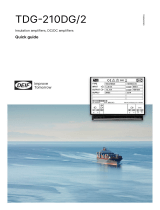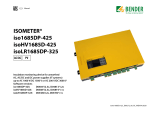Page is loading ...

DEIF A/S Tel.: (+45) 9614 9614
Frisenborgvej 33, DK-7800 Skive Fax: (+45) 9614 9615
Denmark E-mail: deif@deif.com
DEIF A/
S
Installation/operation instructions
Insulation monitor type DIM-Q
4189330015C (UK)
Monitoring of insulation resistance on an AC network
Working voltage up to 690V AC, withstands up to
1000V DC
Measuring range 0...1Mohm or 0...10Mohm
Alarm on exceeding the adjusted set point
Interchangeable scales
AC auxiliary voltage
2,0 2
Zi
i

Generally
Description
The DIM-Q can be used for insulation monitoring on a single-phase or a 3-phase IT
system with or without neutral. The special characteristic of an IT power system is the
fact that no live conductor is connected directly to earth. The DIM-Q is connected to
the power system by connecting the terminal marked P to one of the phases (or the
neutral). The PE input is then connected to the safety cable. To be able to monitor any
kind of insulation failure, all accessible conductive building structures must be
connected to the cable marked PE (protective earth).
Installation
Connection
If a test function is desirable, an arrangement based on a resistor and a push-button
can be mounted as illustrated on the drawings below. The value of the resistor can be
any value from 0 to the max. allowed insulation value. The DIM-Q can be supplied
from the IT system under supervision, but it can also be supplied from another source.
Connection of auxiliary supply
Type: 80...152V AC Type: 176...288V AC Type: 320...576V AC
X1, X2: 100V AC ±20% X1, X2: 220V AC ±20% X1, X2: 400V AC ±20%
X1, X3: 110V AC ±20% X1, X3: 230V AC ±20% X1, X3: 450V AC ±20%
X1, X4: 127V AC ±20% X1, X4: 240V AC ±20% X1, X4: 480V AC ±20%
L
PE
22k/
220k
TEST
312 PPE X4 X3 X2 X1 X1X2X3X4PE P213
TEST
220k
22k/
PE
N
L
1
L2
L3
N

Installation/operation instructions DIM-Q
Page 3 of 10 4189330015C (UK)
Dimensions

Configuration of the relay function
The relay contact can be configured to either a normally energized contact (NE) or a
normally de-energized contact (ND). ND function is recommended, if the DIM-Q is
supplied from the IT system under supervision, because a disconnection of the supply
will not result in an alarm. Figure 1 below shows the location of the switch S1 on the
PCB for selection of either ND or NE relay function. The PCB is located under the lid.
Figure 1
Example: • Max. 50μF leakage capacitor is selected
• 1M is selected as measuring range
• ND is selected as relay function
50µF
1M
ND
500µF
10M
NE

Installation/operation instructions DIM-Q
Page 5 of 10 4189330015C (UK)
Configuration of the measuring range
The DIM-Q can be configured for measuring range 0…1M with 22k on the scale
centre or for 0…10M with 220k on the scale centre. Figure 1 shows the position of
the switch for selection of either 1M or 10M measuring range. Please notice that a
change of measuring range also involves a change of scale. Change of scale can be
done by following the instructions below.
Figure 2
Interrupt signal/supply to the terminals before exchanging the scale
Push the scale cover towards the rear edge
Remove the scale by means of a screwdriver or the like
Insert new scale and press gently till it snaps into place
Push the scale cover back again, after this the unit is ready for mounting
Adjustment of the set point
The requested alarm limit value is
set on an ohm scale on the rear of
the instrument, see Figure 3.
Range "x10" is marked:
The scale values on the ohm scale
are multiplied by 10.
Typical setting:
Insulation resistance corresponding
to lower limit of the section marked
with red on the scale.
Figure 3
i
i
Z
2
2,0
i
i
Z
2
2,0

Operation
Indicators
The DIM-Q is equipped with 3 LED indicators, one green and 2 red LEDs. Only the
green indicator marked SUPERVISION is lit when the unit is connected to auxiliary
supply and no insulation error is detected. If the DIM-Q detects a change in the
insulation measurement, the SUPERVISION LED starts flashing with a fast rate. If the
insulation error detected is fluctuating, the internal integration time is automatically
extended, which is indicated by a slower flash rate. As long as the SUPERVISION
LED is flashing, the latest measured value is kept and indicated on the instrument
until a new value is found, then the reading on the instrument is updated.
The 2 red LED indicators marked +FAULT and -FAULT are illuminated, if an insulation
error below the set point is detected. If a DC voltage (component) occurs on the
system together with an insulation error, the +FAULT or the -FAULT LED is
illuminated, indicating the polarity of the DC voltage. This function will indicate the
reason for the insulation error. In case only one red LED is illuminated, the fault is to
be found in a load with a built-in rectifier, e.g. a frequency converter.
If a DC voltage is detected, but the alarm limit value is not yet reached, the +FAULT or
the -FAULT LED will flash to indicate that there is a DC component higher than 50V
DC between the power system and earth (PE), but no insulation error below the alarm
limit value yet. Figure 4 on the next page illustrates a situation where a DC can occur
between the P and the PE input of the DIM-Q.

Installation/operation instructions DIM-Q
Page 7 of 10 4189330015C (UK)
Figure 4
The capacitor marked C illustrates the leakage capacitor.
The diodes marked 1 and 2 illustrate the rectifier in the load.
If the situation is as illustrated at diode marked 2, the +FAULT LED is illuminated.
If the situation is as illustrated at diode marked 1, the -FAULT LED is illuminated.
Response time after a reset
If a leakage capacitor is <1μF and the insulation resistance does not fluctuate, the
response time will be ≤10 seconds. For further information on response times - see
the table below.
Insulation resistance
between P and PE
Leakage capacitor on
an IT power system
k 50μF 500μF
0 6 sec. 10 sec.
10 6 sec. 125 sec.
100 200 sec. 1000 sec.
1000 200 sec. 1750 sec.
10000 200 sec. 1750 sec.
If a test button is implemented (see the connection diagram on page 2) it is
recommended to reset the DIM-Q by disconnecting and reconnecting the auxiliary
supply (reset time 1 second) in connection with activation of the test button to obtain a
response time of 6 seconds. If the DIM-Q is set to 500μF, the response time in
connection with a test will likewise be 6 seconds.

Response time on duty
Settings 50μF or 500μF with actual leakage capacitor 1μF:
Step in insulation error
- From 1M to 1k: Response time max. 10 seconds
- From 1k to 1M: Response time max. 10 seconds
Setting 50μF with actual leakage capacitor 50μF:
- From 1M to 1k: Response time max. 120 seconds
- From 1k to 1M: Response time max. 240 seconds
Setting 500μF with actual leakage capacitor 500μF:
- From 1M to 1k: Response time max. 800 seconds
- From 1k to 1M: Response time max. 1600 seconds
Note:
If the insulation error is fluctuating (indicated by a flashing SUPERVISION LED), the
above response times will be prolonged.
Power-up
The first 15 seconds after a power-up the DIM-Q is turned into a fast measuring mode.
This mode is useful when a switchboard test is carried out, or if the set point has to be
adjusted to match a test resistor (see above regarding reset of the DIM-Q). After 15
seconds the DIM-Q is automatically turned into normal measuring mode. If there is a
leakage capacitor in the system the DIM-Q will indicate an insulation error for the first
15 seconds after a power-up. If the set point is exceeded the 2 red LEDs will be lit, but
the relay output is inhibited for the first 15 seconds after power-up.
Fuses:
Recommended fuse for aux. supply X2, X3, X4 max. 2A.

Installation/operation instructions DIM-Q
Page 9 of 10 4189330015C (UK)
Technical specifications
Measuring
Measuring circuit DC resistance (Ri): 300k ±1%
AC impedance (Zi): 251k ±1% at 50Hz
Measuring voltage: ±28V DC ±5%
Mains voltage /
leakage cap.:
Max. 690V AC +20% continuously /
max. 1000V DC continuously / max.
50μF leakage capacitor or max. 500μF
leakage capacitor
Instrument Measuring range: 1M / 10M
- Accuracy: ±5% of scale length (1M) / ±2% of
scale length (10M)
- Temperature drift: Max. 0.5% of scale length per 10°C
- Aux. supply
influence:
Max. 0.2% of scale length at
Us +20...-15%
Max. 5.0% at scale centre at
Us -15...-20%
- Response time: Depends on the actual insulation error /
leakage capacitor (see table on page
7)
Scale: Exchangeable, with red section
Set point/relay
Set point: 0…1000k / 0…10000k corresponding to 22k or 220k at
scale centre
- Accuracy: ±5% of scale length for potentiometer
- Reproduceability: ±1% of scale length for potentiometer
- Hysteresis: ±1% of scale length for potentiometer
- Temperature drift: Max. 0.2% of scale length for potentiometer per 10°C
- Voltage drift: Max. 0.2% of scale length for potentiometer at Us ±20%
- Response time: Same as instrument (the relay is updated simultaneously with
the instrument reading)
Relay output: Change-over contact
Contact rating: AC1: 8A, 250V AC – DC1: 8A, 24V DC
AC15: 3A, 250V AC – DC13: 3A, 24V DC
Life mechanical: 2 x 107 operations
Life electrical: 1 x 105 operations
Relay coupling: Normally energized NE or normally de-energized ND

Page 10 of 10 Tel.: (+45) 9614 9614 Fax: (+45) 9614 9615 E-mail: [email protected]
General technical specifications
Auxiliary voltage: 100-110-127V AC or 220-230-240V AC or 400-450-480V AC
±20% 40...70Hz (≤4VA)
EMC:
(see Note 1)
To IEC 61000-6-1, 61000-6-2, 61000-6-3, 61000-6-4,
SS4361503 (PL4) and IEC 255-4 (class 3)
Galv. separation: Relay output / measuring circuit / aux. voltage: 3.25kV - 50Hz -
1 min.
Temperature: -10...55°C (nominal), -25...60°C (operating), -25...65°C
(storage)
Climate: Class HUE, to DIN 40040
Protection: Instrument: IP52 / IP54. Electronics: IP20. Terminals: IP20. To
IEC 529 and EN 60529
Connections: Screw terminals: 2.5 mm
2
(multi-stranded), 4 mm
2
(single-
stranded)
Materials: All plastic materials are self-extinguishing to UL94 (V0)
Note 1:
The DIM-Q is CE marked for residential, commercial and light industry plus industrial
environment. Regarding approvals, please see our homepage, www.deif.com, search
for DIM-Q under the menu Documentation.
Warning:
If the installation is to be tested by means of a high-voltage "MEGGER", the
measuring leads to the DIM-Q at terminal "p" must be disconnected before testing is
carried out. Omitting this may result in damage to the DIM-Q, if the test voltage is
higher than 1000V AC/DC. Besides the insulation test will be affected by the built-in
DC voltage generator impedance (approx. 250k
).
For further information regarding the measurement method used in the DIM-Q or other
technical specifications, please see the data sheet, document no. 4921230018.
Errors and changes excepted
/












